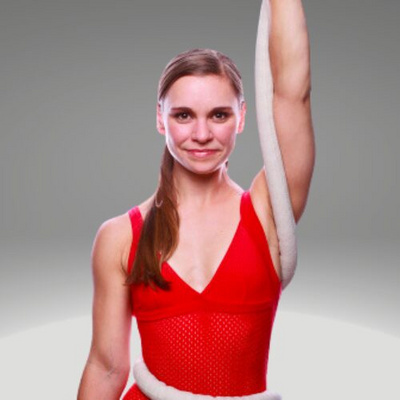Is non-binary the modern feminism? An interview with Frédérique Cournoyer Lessard
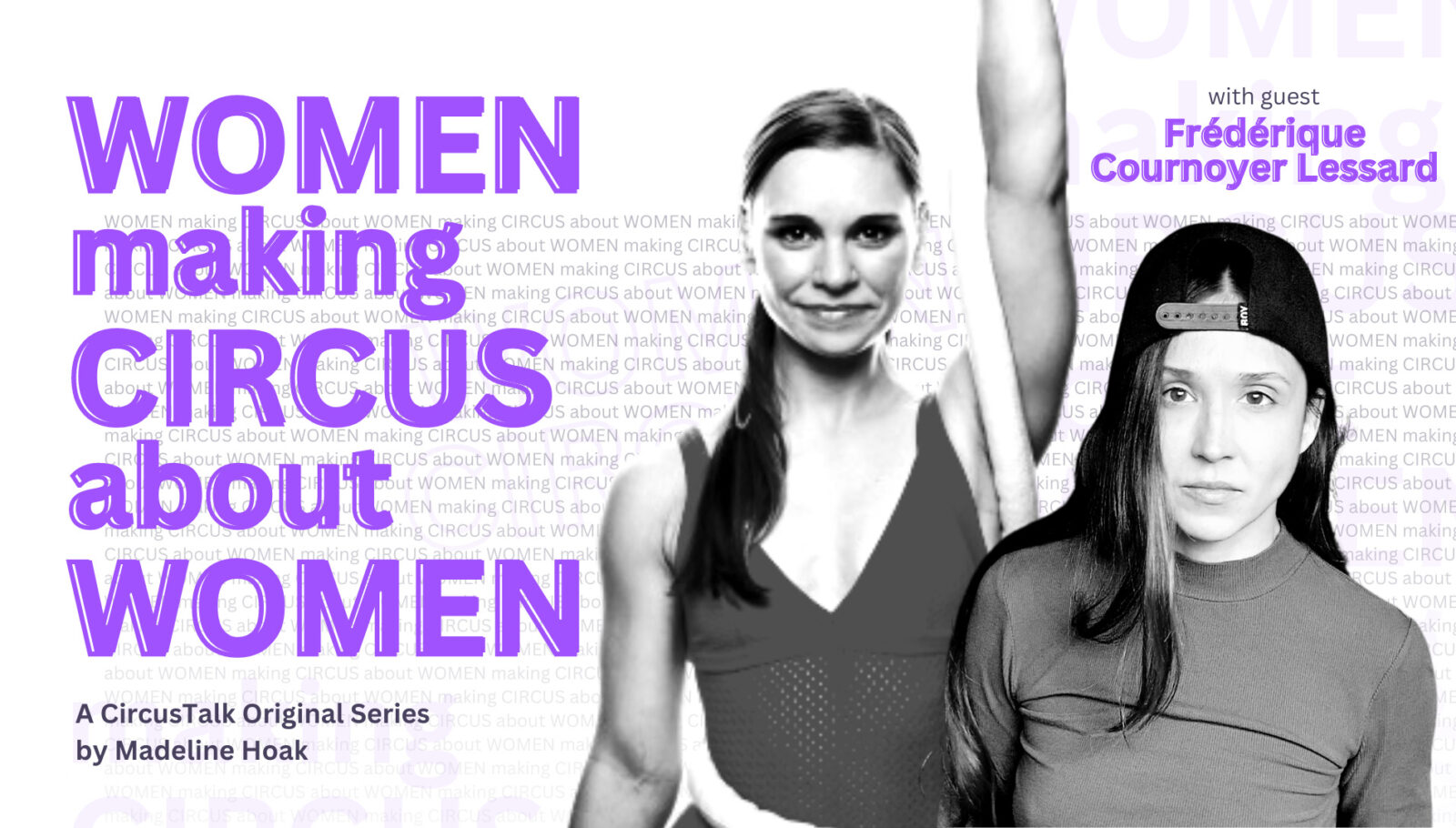
Frédérique Cournoyer Lessard is an interdisciplinary artist working through circus and film. I first saw their work at the Montréal Complètement Cirque Festival (2022) at La Chapelle, an intimate theater just north of Mount Royal Park. Their solo show, Scuse– while presented as a work in progress – was the most thoughtful and impactful piece I saw at the festival. Lessard has been top on my list for this series:“When I started the process of Scuse, I was really trying – maybe naively – to answer ‘What is it to be a woman [today]? Am I a woman? What is a woman?’ How wide, and abstract, and complex is this question!” While Lessard was crafting Scuse, they had also enrolled in a university gender studies program. “Very quickly I realized this question was impossible to answer. Everyone is different. There is no answer.” Lessard shifted their inquiry to, “What is the perception of femininity that society instills in us? And how does this perception, and the behaviors that come with that perception, encourage me to fall into a pattern or a trap of being sexually abused? What are the very simple things – actions, behaviors, words – that create the binary without us even noticing?” Based on personal experiences, Lessard’s work puts the gender binary and sexual violance side by side, and asks, “If we don’t have such a big gap between genders would we have as much sexual violence?” Lessard admitted, “I don’t have a specific answer,” but an answer is not what they are seeking through their art.

Despite the direct connection of Lessard’s work and the theme of this series, Lessard was generous with their personal reaction to the title. “To be very honest, I felt a bit anxious. Not a big feeling of anxiety, but still a little shiver of discomfort, you know? And a subtle feeling of being stuck into that tag. This feeling is actually the starting point of my solo show, and the starting point of my personal reflection. Why [does] being tagged very clearly as a woman create a feeling of being stuck, or a feeling of being unsafe, for me? It’s something that I need to address. But in your email, you clarified the vision of a woman including non-binary people, and already I felt safe. I felt a big release from that point. Already, just with the title, I felt connected with it because it was [connected to] something inside me. I’m an artist. I’m not an activist. But if I were a political activist, I would like to fight for gender language for everyone, because I feel that that would reduce the domination and the difference [between the genders]. Scuse is all about that.” Lessard prefaced this with a personal comment about their own identification and pronouns. “The simplest way to express it is that I really feel that I am a gender-neutral soul living in a female body. This is why I’m really comfortable with the pronoun ‘she’ because I’m not rejecting my body. I’m not rejecting the common past with other people living in a female body. That creates a connection and understanding. And also the way we were educated because we were living in a female body creates some sort of identity. But when people use ‘they,’ they know me deeper and they are closer to my own identity.”
I asked Lessard if Scusewas the only work in their portfolio that spoke to these themes. “Since the beginning of my artistic career, I’ve been addressing sexual violence. Not directly sexual abuse, but domination between genders. Even before noticing that my work was feminist, I think that it was always around feminist topics and themes,” Lessard said. “I always had this really complex or non-linear relationship to my own femininity,” but the “link between what we consider ‘woman’ and the connection with sexual violence,” and “the relationship between gender binary and sexual violence really opened up after the Victims Voices Montreal and Me Too movements.” In the last moments of Scuse, Lessard tells the audience, “the two moments in my whole life that I felt most connected to my sex as a female was when I felt that I was so fat and disgusting in my body, and after Victim Voices and Me Too, when I felt I was sexually abused like so many women. I felt so ashamed that I hadn’t felt adequate with my female body. I was ashamed, so ashamed. That feeling – and to accept that that was the truth – it’s such a shame. This is why I need to address [these topics].”
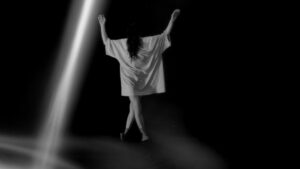
The wider cultural conversations of Victim Voices and Me Too not only validated Lessard’s personal reflections, but also gave the greater public a means and language to talk about gender and sexual violence. “The social consciousness we are developing is really helping to have a new vocabulary that brings new ways of thinking and new ways of understanding yourself. This is another thing that really helped me to put the pieces of the puzzle together and find my way, and my peace, my balance.”
At the end of Scuse, Lessard and Estelle Frenette-Vallières (she/her), the visual designer for the production and Lessard’s real-life, long-time friend who is present on stage for the duration of the work,sat down in front of the audience and specifically asked us to continue the conversation. They wanted us to ask each other:Would there be as much violence towards women if we didn’t live in a society that educated its boys and girls so differently? By limiting the division between the genders, would we have more equality? Is non-binarity the modern feminism? “The most important thing with Scuse is not about being good on stage, or being a good show artistically. The most important thing is that it creates some discussion space between people after the show.”
People carried questions home with them; they spoke about it on the car ride away from the theater, they had discussions with partners, friends, and family. “I was so glad that Scuse was creating that effect,” Lessard said. “[The show is] there to open discussions, not to try to bring my ideas into people’s thoughts; to open up their reflection about their own gender identity, behaviors, or sexual behaviors.” I asked if one conversation or one reflection stuck out. “Not one specific comment, but it was more the fact that I realized how many people were feeling [similarly]. I think that we were not really addressing these questions, socially, ten years ago. Now that we are addressing [them] more, a lot of people are feeling it, but without having done the conscious reflection.”
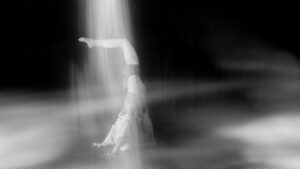 Noting that these are sensitive topics that could affect audience members in a triggering or negative way, I asked Lessard if anyone had responded to the work with malice or pushback. “Not at all. Most of the events I’m talking about in the show are autobiographical. It happened when I was a kid and teenager, and then I did my own process with therapy. Scuseis emotional, but for me, it’s okay because I did my process. But I realize the impact can be stronger on [other] people rather than me because they haven’t addressed that memory in their own past.” Lessard talked about how they reached that point: “Therapy, but also my aerial hoop is my safe space. It’s always been a place where I could vent and process unconscious feelings. It’s always there. I can stay hours in my aerial hoop without doing anything, without doing technique, but to feel connected in a safe space where I can come back with my body, and feeling comfortable with my body without sexual perception from others.”
Noting that these are sensitive topics that could affect audience members in a triggering or negative way, I asked Lessard if anyone had responded to the work with malice or pushback. “Not at all. Most of the events I’m talking about in the show are autobiographical. It happened when I was a kid and teenager, and then I did my own process with therapy. Scuseis emotional, but for me, it’s okay because I did my process. But I realize the impact can be stronger on [other] people rather than me because they haven’t addressed that memory in their own past.” Lessard talked about how they reached that point: “Therapy, but also my aerial hoop is my safe space. It’s always been a place where I could vent and process unconscious feelings. It’s always there. I can stay hours in my aerial hoop without doing anything, without doing technique, but to feel connected in a safe space where I can come back with my body, and feeling comfortable with my body without sexual perception from others.”
When Lessard said that, I couldn’t help but think about a question/conversation that floats around the circus academic world: can the aerial body ever be non-sexualized? As I wrote in my review of Scuse:
These theories say desire and lust are innate in the presence of flight, speed, musculature, physical exertion, and extreme flexibility. It’s easy to perform toward this and to augment choreography with sensual attributes. And sexy circus is vigorously praised…Taken out of context, Lessard’s choreography might have elicited hollers and applause (because circus is sexy, and sexy circus acts are praised)… I felt we [the audience] were being asked to unlearn the innate, sensual definition of aerialists and aerial movement. We were asked to consider the codified ideologies about the discipline–about circus–in a new light.
As we chatted, Lessard recalled a reaction they had to a radio show. “I was so frustrated,” Lessard laughed at the memory. The host, someone whose opinions are validated by their reputed cultural savvy, referred to circus (Cirque du Soleil, more specifically) as pornography. Lessard quoted them, “You’re not going to see circus for the story.” They then mused, “Sometimes I feel like what is really happening inside our world [is so different] than what is happening outside our world. The way media talks about circus needs to change. It’s like a big wheel. And every part has to slowly change. Diversity is there, [but] it’s not there enough.” I agreed that changes have to come at each point in the wheel: one spoke cannot hold the burden of making change and dragging the rest of the circle forward.
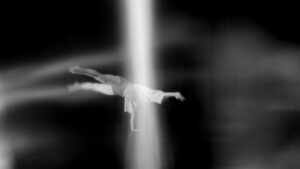
Language is at the center of Scuse and Lessard’s personal journey. “It’s super important, even in my own language, in French, the words I’m going to use. Especially about sexual violence or gender identity because the subtleties and the social connotations can change a lot. The show is about the weight of words. It is built with six sentences that I heard in my childhood and teenage years – six simple sentences. But on the spot, I didn’t really realize how those words stuck inside me and how those words shaped my perception of femininity and sexuality. So the weight of words is the skeleton of the dramaturgy for the show. Those six sentences and how they answer to each other – because some didn’t fit well together, and that was confusing. And those years I didn’t have [language] to process them to feel ‘normal.’ More words in between the two opposites – it helps so much! There are a lot of different pronouns now, but it’s still not the pronouns that are shining.” Shining, yes! This was the perfect way to describe an initial mental grapple I had with this series.
I had shared with Lessard that this series came about because women are supposedly still underrepresented or undervalued in the circus industry. My introductory article to the series questioned that: women are everywhere in circus! Lessard agreed, “We are there! But it’s as if we are there, but we are still following a path that is not – I would say ‘ours,’ but it’s not a good expression because I’m really fighting not to divide.” So, it is not a questifon of existing: women exist in circus; the pronouns exist in our language; diversity is there, stories about the female experience exist. They just need space to shine.
_________
Lessard was extraordinarily accommodating during our interview. They spoke with me in English, but they are more comfortable speaking in French. Because language and clarity is so important, I offered Lessard to send me some thoughts written in French.
When I asked Lessard if anyone had responded negatively to the work, they also spoke about the potential for institutions or companies to want to present Scuse as, one might say, performative allyship rather than from a true interest in making changes to the structure and behaviors of that company or institution. Lessard has clarified their answer here:
Quand on parlait d’une réception négative qu’aurait pu recevoir mon spectacle, j’ai dit que j’ai senti un risque que les institutions ou les compagnies s’intéressent à mon travail pour “nettoyer” leur image sans réellement faire un examen de conscience sur leur propre façon de fonctionner à l’interne et sans mettre en place des protocoles précis afin d’assurer l’équité entre les genres, le respect et l’inclusion des diversités, la sécurité relative aux abus et harcèlements sexuels. Je veux préciser qu’à date, je n’ai PAS vécu directement ce phénomène. Au contraire, j’ai senti une écoute de la part des institutions autour de moi et j’ai senti que certaines d’entre elles avaient une sincère envie d’apporter des changements positifs au milieu.
La mise en garde d’un “faux” intérêt possible envers mon travail est plutôt un “redflag” que je soulève AVANT d’être confronté(e) à cette situation. Je veux m’établir une ligne directrice relative à la diffusion de mon spectacle, car mon objectif avec Scuse n’est pas d’être vu(e) comme un(e) artiste incroyable et de briller au-dessus de mon propos, mais de créer des ponts et d’ouvrir des discussions avec les gens du milieu, comme avec les gens de différentes communautés. J’aimerais que Scuse contribue à une prise de conscience collective que certains comportements liés à la binarité des genres sont toxiques et encouragent de façon insidieuse les abus sexuels et la domination.
D’ailleurs, une fois que Scuse sera terminé et prêt à être diffusé (date de sortie prévue : automne 2024), j’aimerais développer un volet médiation autour du projet. Je désire m’associer avec un(e) psychologue outravailleur(se) social(e) pour offrir une activité de sensibilisation composée du spectacle en première partie et d’une discussion en deuxième partie. J’aimerais pouvoir offrir cette activité dans les écoles secondaires ou dans toutes institutions intéressées à la médiation.
To translate Lessard’s words above to your own language click here.
Because writing for Circus Talk is a specific outlet directly to the circus and performing arts community, I always ask my interviewees if there is something they would like to say to the Circus Talk readership.
Toutes les deux on partage la dichotomie que tu soulèves dans ton article : les femmes (dans sa définition inclusive de toutes personnes s’identifiant femme ou non-binaire) sont bel et bien présent(es) dans le milieu, donc pourquoi avons-nous encore l’impression d’être sous-entendu(es) et sous-représenté(es)? Je ne prétends pas avoir de réponses, mais voici quelques pistes de réflexion que j’aimerais partager avec les gens du milieu.
PARITÉ : Encore en 2023, une grande majorité des spectacles diffusés comptent un nombre plus élevé d’hommes, sur scène comme en coulisses. Au niveau du casting et de la production, je ne comprends pas comment est-ce encore possible que ce ne soit pas une règle de base que chaque compagnie respecte. Pourquoi la parité est une priorité depuis de nombreuses années dans quasi tous les domaines professionnels sauf dans le milieu du cirque? Ça ne devrait même plus être une question. On monte une équipe de création, on prend 50/50+diversité. C’est tout.
Même dans les milieux où les femmes étaient quasi absent(es) il y a 30 ans (en politique ou en cinéma, par exemple), de plus grandes mesures sont prises pour tenter d’atteindre la parité. Je ne comprends pas comment est-ce possible de ne pas y arriver en cirque, alors que chaque année, il y a un nombre quasi paritaire de jeunes qui graduent des écoles professionnelles. (Oui, il y a encore certaines écoles dans le monde qui ne sont pas du tout à jour sur la parité, mais plusieurs le sont.)
La fameuse excuse que, pour tout le travail de groupe, ça prend “deux porteurs” pour “une voltigeuse” ne tient plus. Si justement on s’ouvrait à des corps moins binaires, on n’aurait même plus cette discussion. Des corps dits de femmes peuvent être beaucoup plus massifs que des corps dits d’hommes. Tout ça devrait déjà être acquis en 2023, mais visiblement il y a encore du travail à faire. Ça dépasse aussi le milieu du cirque. Les enfants de sexe féminin plus ronds tout autant que les enfants de sexe masculin plus rachitiques sont sources de moqueries dès les cours d’éducation physique à l’école primaire… évidemment qu’on les retrouve plus difficilement en sports et en cirque à l’âge adulte.
REPRÉSENTATIVITÉ : Il y a aussi une responsabilité au niveau des programmateurs, diffuseurs et commissaires. Même si plusieurs spectacles produits sont encore majoritairement masculins et suivent des codes hyper genrés, plusieurs spectacles mettent aussi en valeur les femmes, présentent une diversité des genres et/ou déconstruisent les clichés autour des sexes binaires. Non seulement concernant la parité ou la représentativité visible sur scène, mais aussi au niveau du contenu, du ton, du style et de l’approche. Je ne comprends pas pourquoi dans une programmation, il n’y a pas ce devoir de créer un équilibre, un reflet plus juste du milieu, une image plus actuelle de notre médium? Est-ce que les programmateurs ont peur que la demande du public ne soit pas là? Car le public est prêt. Le public est même lassé de voir toujours le même type de cirque.
Parfois, je sens même que nous sommes la risée, tellement nous n’offrons pas de diversité et de profondeur dans nos spectacles. J’ai été tellement blessé(e) cette semaine quand j’ai entendu à la radio publique, dans le cadre d’une émission culturelle qui jouit d’une certaine crédibilité intellectuelle, la journaliste dire : “Le cirque, c’est comme la pronorgaphie, on n’y va pas pour l’histoire”. (1) Et toute la table de chroniqueur.ses culturel.les qui pouffent de rire…ouch.
À l’interne, nous le savons. Le vrai cirque, ce n’est pasça. Oui, il y a deça, mais pas justeça. Exactement comme il y a les blockbusters hollywoodiens qui continuent à véhiculer des valeurs misogynes, homophobes, transphobes ou racistes, c’est vrai qu’il y a plusieurs spectacles de cirque problématiques. Mais je refuse de laisser sombrer le cirque en tant que médium sous cette réputation. J’ai tellement de collègues et amis qui font du cirque un art sensible, profond, puissant, unique, complexe, réfléchi, nuancé, provoquant et avant-gardiste. C’est donc en partie la responsabilité des diffuseurs, de nous aider à être mieux représenté(es).
To translate Lessard’s words above to your own language click here.
(1) Culture Club, Radio-Canada, Animateur : René Homier-Roy, Chroniqueuse : Catherine Genest qui cite Michèle Nicole Provencher, diffusion 29 avril 2023.
*N’empêche que le spectacle ECHO du Cirque du Soleil qui était le sujet de critique de la journaliste comportait environ 5 artistes femmes pour une 40aine d’artistes de cirque sur scène. Je dis bien “environ”, car je ne veux pas assumer le genre de chaque artiste sans leur avoir demandé.
CHAQUE PETITE CHOSE : Je crois que la responsabilité repose aussi sur chaque individu. Si nous sommes dans un cadre où nous ne nous sentons pas respecté(es) ou écouté(es), il faut parler. Même si ce sont de tous “petits” détails, “petits” gestes, “petits” commentaires…un tout petit centimètre manquant sur la longueur d’une jupe, une seule phrase semi-misogyne-même-pas-si-pire que nous devons nous-même dire sur scène, une petite blague déplacée que seulement deux personnes ont entendues dans les loges, un tout petit 15 minutes de plus non réchauffé(e) sur une journée entière de répétition, un simple compte de huit dans l’ensemble d’une chorégraphie…il ne faut pas minimiser le pouvoir de tous ces petits détails. Car ce sont eux qui constituent nos systèmes, nos mentalités, nos cultures.
Je sais que c’est beaucoup plus facile de passer par-dessus, car nous sommes devenu(es) expert(es) dans l’art de refouler ce qui nous irrite, de penser que c’est en partie de notre faute, de prendre sur nous en nous disant que “c’est pas si pire”. Mais c’est important. Car même si nous étions 90% de femmes (ou hommes féministes) dans le milieu, mais que nous nous moulons à un système de valeurs mis en place par des hommes pour des hommes, nous n’aurons jamais l’impression d’exister pour qui nous sommes vraiment. Nous allons toujours nous sentir opprimé(es) et sous-représenté(es). Ce sont des théories féministes adressées depuis plusieurs années déjà, mais elles sont encore vraies.
Car oui, plusieurs femmes ont atteint des postes de direction et de diffusion dans le milieu. Mais est-ce que ces femmes ont réellement la liberté de travailler comme elles l’aimeraient et de mettre en application leurs propres valeurs? Est-ce que pour réussir à atteindre et conserver ces positions, les femmes (et hommes féministes) doivent se soumettre au cadre déjà existant? Encore une fois, ça prend du courage et il faut parfois se mettre individuellement en danger pour prendre parole, mais je crois que c’est important.
*J’utilise consciemment les accords neutres même quand je parle des femmes
For (1) note translation click here.
All images courtesy of Frédérique Cournoyer Lessard.
Editor's Note: At StageLync, an international platform for the performing arts, we celebrate the diversity of our writers' backgrounds. We recognize and support their choice to use either American or British English in their articles, respecting their individual preferences and origins. This policy allows us to embrace a wide range of linguistic expressions, enriching our content and reflecting the global nature of our community.
🎧 Join us on the StageLync Podcast for inspiring stories from the world of performing arts! Tune in to hear from the creative minds who bring magic to life, both onstage and behind the scenes. 🎙️ 👉 Listen now!
